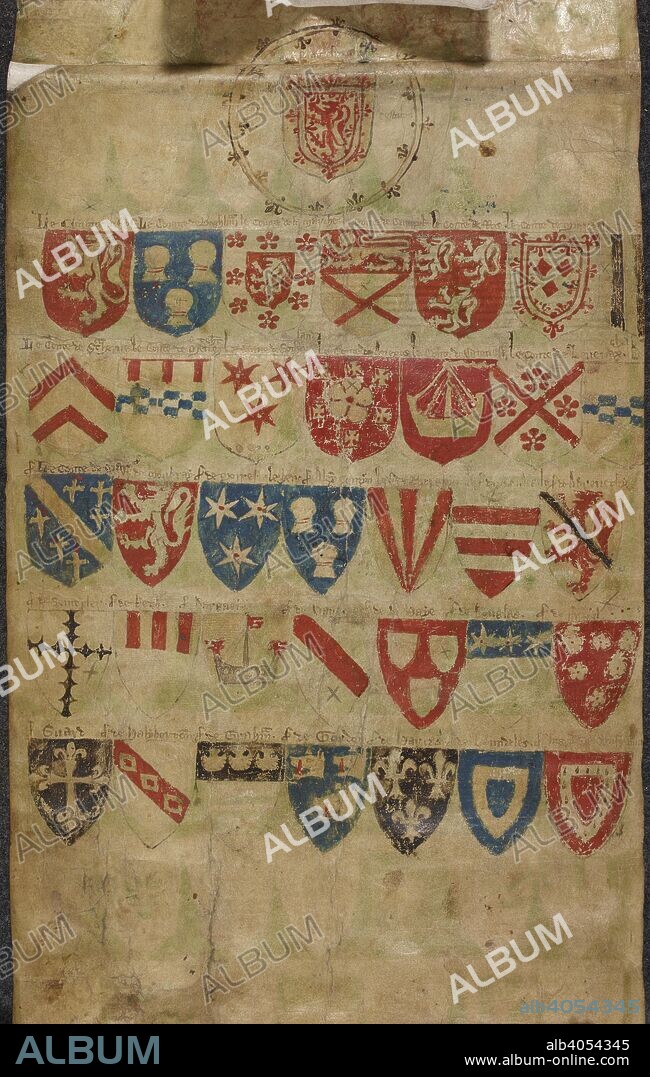alb4054345
The Balliol Roll is painted on the dorse of the last membrane of Cooke’s Ordinary. It contains the arms of Edward Balliol (d. 1364), claimant to the Scottish throne, followed by the shields of thirty-five of his chief supporters, arranged in five rows of seven, together with the name of each bearer of arms. Cooke's Ordinary and the Balliol Roll. England, c.1340. Cooke’s Ordinary is reputedly the oldest European ordinary of arms in existence; England, c 1340. Latin. It comprises seven membranes (the first of which is fragmentary), containing 589 shields arranged by charge in eighty-eight rows, with accompanying names, to allow the user to identify the holders of particular arms. Source: Add. Roll. 77242. Language: Latin.

|
Ajouter à une autre Lightbox |
|
Ajouter à une autre Lightbox |



Avez-vous déjà un compte? S'identifier
Vous n'avez pas de compte ? S'inscrire
Acheter cette image

Légende:
Voir la traduction automatique
The Balliol Roll is painted on the dorse of the last membrane of Cooke’s Ordinary. It contains the arms of Edward Balliol (d. 1364), claimant to the Scottish throne, followed by the shields of thirty-five of his chief supporters, arranged in five rows of seven, together with the name of each bearer of arms. Cooke's Ordinary and the Balliol Roll. England, c.1340. Cooke’s Ordinary is reputedly the oldest European ordinary of arms in existence; England, c 1340. Latin. It comprises seven membranes (the first of which is fragmentary), containing 589 shields arranged by charge in eighty-eight rows, with accompanying names, to allow the user to identify the holders of particular arms. Source: Add. Roll. 77242. Language: Latin.
Crédit:
Album / British Library
Autorisations:
Modèle: Non - Propriété: Non
Questions sur les droits?
Questions sur les droits?
Taille de l'image:
4592 x 7230 px | 95.0 MB
Taille d'impression:
38.9 x 61.2 cm | 15.3 x 24.1 in (300 dpi)
Mots clés:
14 14E 14EME XIV XIVE XIVEME SIECLE • 14E SIECLE • 14EME S • ANIMAUX MYTHIQUES • ARISTOCRATE • ARISTOCRATES, ARISTOCRATIE • ARISTOCRATIE • ARMEE: CUIRASSIER • ARMOIRIES (NOBLESSE) • ARMURE • ARMURE: BOUCLIERS • ARMURE: CUIRASSE • ARMURE: PLAQUE PECTORALE • ARMURE: PLAQUE PERCTORALE • BOUCLIER • BOUCLIERS • CUIRASSE • CUIRASSES • CUIRASSES, ARMURE • CUIRASSIER • ÉCU • GENS • HARNAIS (ARMURE) • INDICATEUR • MORION • NOBLE • NOBLES • NOBLESSE • PECTORAL, PLAQUE ARMURE • PLAQUE PECTORALE • PLAQUE PERCTORALE • PLASTRON (ARMURE) • QUATORZIÈME SIÈCLE • XIVE SIECLE
 Pinterest
Pinterest Twitter
Twitter Facebook
Facebook Copier le lien
Copier le lien Email
Email
